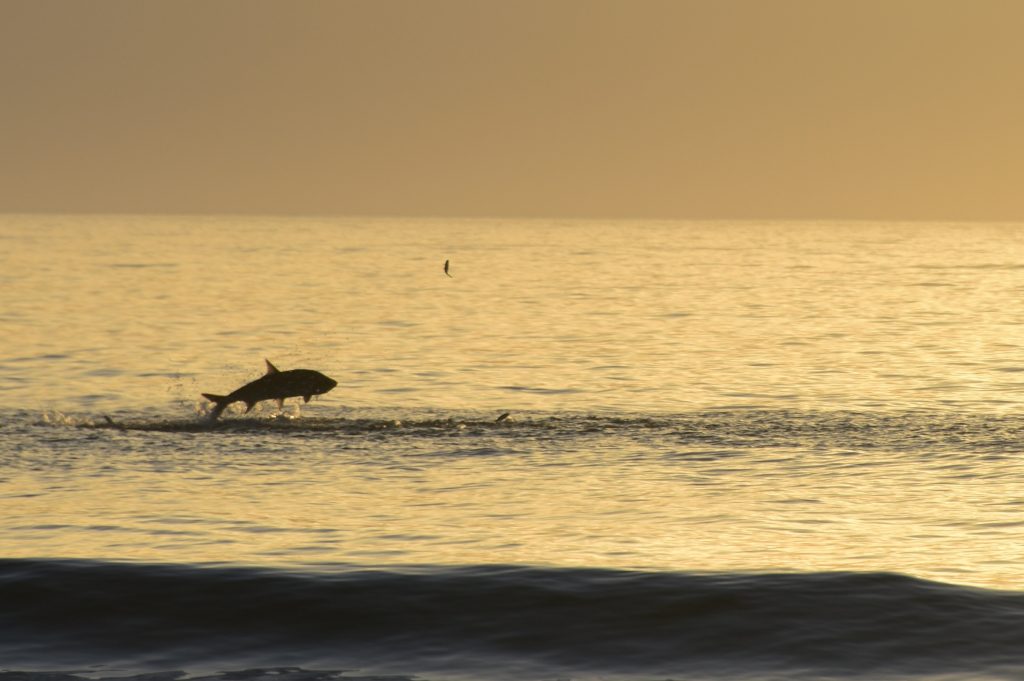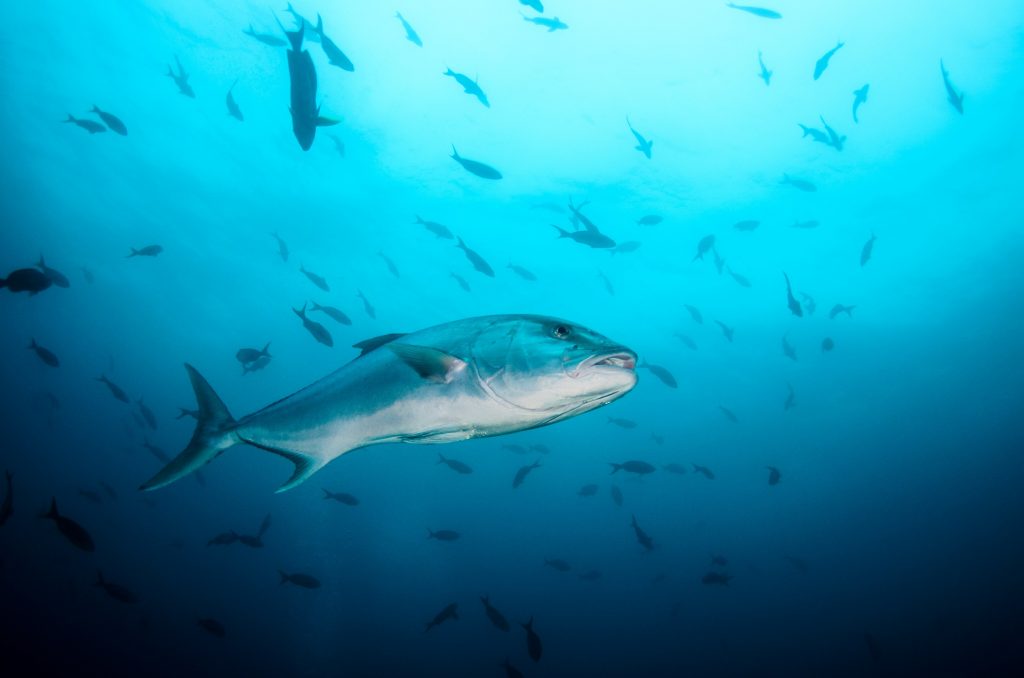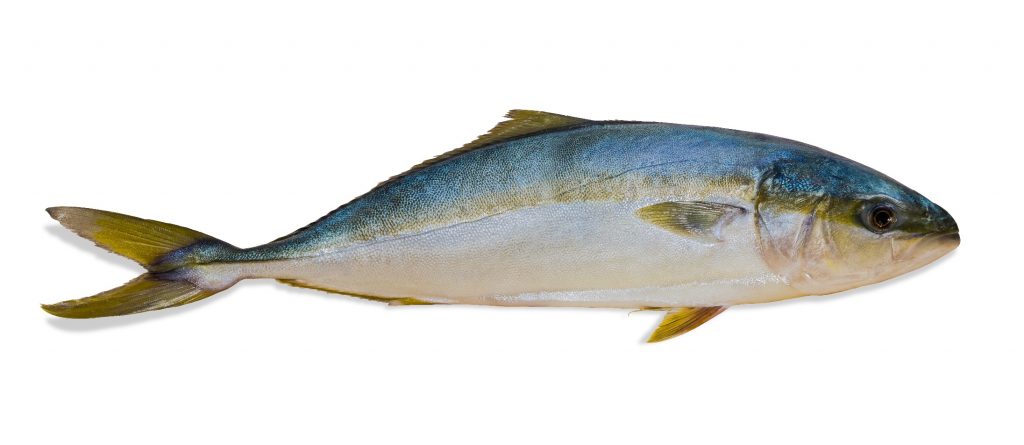
Any seasoned fisherman will tell you that amberjack fishing isn’t child’s play. The salt-water fish are notorious line and reel breakers, and this is because they’re strong swimmers that can grow to weigh up to 140lbs. Amberjack fishing is a rewarding sport mainly because it is so difficult to catch one. Though a wide array of bait can entice the fish (their diet includes crustaceans, small fish, and cephalopods) their stubbornness makes them one of the toughest fish species to successfully catch.
Being voracious predators, amberjack fish rarely resist taking the bait. Reeling them in is the hard part specifically because they have a very powerful counter-pull. They tend to rip into the bait quickly then pull the hook downwards towards the bottom of the ocean. This maneuver, coupled with their impressive strength, is usually enough to break weaker lines and reels, and it often results in their freedom. Therefore, in addition to having the sturdy equipment, amberjack fishing also requires lots of physical strength. For that reason, amberjack fishing typically isn’t for kids, the elderly, or the sick.
What Are Amberjack Fish?

Amberjack fish are a carnivorous type of saltwater fish typically found in regions of the Pacific, Atlantic, Southern, and Indian oceans. They are moderately large and can weigh between 40lbs and 140lbs. Amberjack fish commonly prey on crustaceans and smaller fish, but they are particularly attracted to cephalopods. Nevertheless, they aren’t picky, so it is unlikely that an amberjack fish would ignore your bait.
Though they are primarily caught for sport, amberjack fish are a delicacy in some parts of the world. The firm, pink flesh of this voracious fish is mildly sweet with a buttery taste. The fish lack scales so they can be consumed whole save for the bones. However, amberjack caught straight from the ocean is not exactly safe to eat. They tend to be infested by worms and parasites, and the cleaning process can be quite tedious.
Farmed amberjack fish, on the other hand, are typically reared for human consumption.
Fishing for amberjack requires resilience and robust fishing equipment. Their sheer power is enough to break lines and snap rods that don’t measure up to its strength, so it is essential to be prepared with the right tools. On the plus side, the fish are not intimidated by loud noises, so there’s little chance of you scaring them away unintentionally.
Common Habitats of Amberjack

Amberjack is commonly found in the warm temperate waters of the open sea. Some species of the fish, however, are more concentrated in the cool waters around the coast of Florida and Georgia. Others, especially the younglings, survive in less than 30 feet of water. These are the most easily caught by buoyant lures.
Other species prefer to reside in the depths of the ocean. As such, you will only catch these fish in deep waters and with equipment that sinks low enough for them to spot. Jacks can go to up to depths of 240 feet under water, but you’ll find some species in depths of less than a hundred feet.
Anglers rarely have to go far into the ocean because amberjack fish are concentrated on coastlines in high numbers.
Though yellowtail jacks (a type of amberjack fish) mature out in the open ocean, they often relocate to coral reefs when they reach their adult stage.
Types of Amberjack
-
- Greater Amberjack
The greater amberjack is the largest type of amberjack fish there is. They weigh an average of 40 pounds, but some grow to weigh over 200 pounds. The fish can be distinguished by their silver undersides and blue-gray backs, but it is the amber stripe running lengthwise along their bodies that is commonly used to identify them. You’ll find these big game fish roaming the open ocean since they prefer the temperate waters there. In the Gulf of Mexico, they’re considered an endangered species. - Yellowtail Amberjack
 Yellowtails are typically smaller than the greater amberjack. Their distinguishing characteristics are their yellow forked tail fins and torpedo-like bodies. They are highly efficient swimmers and among the four most commonly found species of amberjack.
Yellowtails are typically smaller than the greater amberjack. Their distinguishing characteristics are their yellow forked tail fins and torpedo-like bodies. They are highly efficient swimmers and among the four most commonly found species of amberjack. - Banded Rudderfish
 Often mistaken for the pilot fish due to their similar appearance, banded rudderfish are even smaller than yellowtail jacks. The vertical bands that run across their bodies are identical to those of the pilot fish so to identify a banded rudderfish, look out for a gold stripe running along the length of its body. Additionally, banded rudderfish have a first dorsal fin, which pilot fish do not.
Often mistaken for the pilot fish due to their similar appearance, banded rudderfish are even smaller than yellowtail jacks. The vertical bands that run across their bodies are identical to those of the pilot fish so to identify a banded rudderfish, look out for a gold stripe running along the length of its body. Additionally, banded rudderfish have a first dorsal fin, which pilot fish do not. - Lesser Amberjack
The smallest species of amberjack weighs about ten pounds on average. These small fish can be quickly identified by their eyes, which are usually larger than those of the greater jacks. The other distinguishing feature of this species of amberjack is the color of its back, a dark shade of green-brown. Despite being the smallest of the jacks, they are excellent predators that often reside in deeper waters than those inhabited by the greater amberjack.
- Greater Amberjack
Best Amberjack Fishing Equipment
Amberjack fish are speedy, efficient swimmers that usually escape using their rod-snapping force. If you’ve never fished for jacks before, you’ll need to upgrade your fishing equipment to improve your chances of catching the saltwater predators. Their strength and swimming power are however canceled out by their environmental awareness. The fish rarely get scared off by sudden loud noises, so they should be easy to spot.
Even so, every fisher who has successfully caught an amberjack fish before knows that the battle doesn’t begin until the fish is firmly attached to the hook. They are notorious for using their weight and strength to break away, sometimes with such force that they leave the reel, rod, or line broken. Equipment used to fish for amberjack should, therefore, be very robust.
-
-
- Rods – Amberjack fish are strong and heavy. Your rod should be able to support lines that can hold up to 80 pounds without problems. At the same time, it should be strong enough to pull the heavy game fish away from its escape route without damaging the line. Casting rods are a simple yet reliable choice when it comes to amberjack fishing.
- Reels – As crucial as it is to have a sturdy fishing rod, the strength, and resilience of the reel and the line you use will have a more significant influence on your ability to catch this evasive game fish. After all, the biggest challenge when dealing with jacks is getting them out of the water. For this, you’ll need a spinning reel (medium gear ratio is preferable), as it can be used to draw out the amberjack fish that live in deeper waters.
Spinning reels also indicate the number of rotations made by the spool. Big game amberjacks may sometimes necessitate the use of heavy reels. These reels typically hold 60 to 80-pound lines and can withstand a minimum of 25 pounds. Their sturdiness and ability to sustain large weights are what an amberjack fisherman depends on to yank in the big fish. - Lines – The counter pull exerted by greater amberjacks is enough to break almost any fishing line. For that specific reason, you cannot use a line that isn’t braided or is not a monofilament line. Braided lines cut through ocean currents much better and can drag out a jack from deep waters over long distances without succumbing to the extreme tug on both sides. The latter type of fishing line is often used for deep sea fishing, making it ideal for the yellowtail species.
- Lures – Artificial lures can be just as effective when it comes to amberjack fishing because they are naturally aggressive predators. Enticing them is almost entirely a matter of finding the right lure. Plugs work for jacks that live in shallow waters since they’re hollow and buoyant. Spoons and jigs are ideal for fish in deeper waters. Jigs are soft-bodied and can be made out of metal to reduce buoyancy. Spoons, on the other hand, are hard-bodied lures that are shaped like ovals and are heavy enough to sink to deeper waters where some species of amberjack reside.
- Baits – Anglers have a lot of options when it comes to baits for amberjack fish. That’s because crabs, shrimp, octopi, sardines, cigar minnows, squids, and a large number of other marine animals make up a significant part of these predators’ diets. Jacks especially love cephalopods since they’re much easier to prey on. However, they are ocean predators that can be enticed by a number of other types of small fish.
- Hooks – Circle hooks, jig hooks, bait hooks, and other large hooks are generally useful when it comes to catching jacks. Anglers usually spring for stainless steel hooks since these make it easier to release catches that are too small. This type of fish is rarely captured by accident, and so the practice is considered sustainable, more so when you weigh in the fact that most amberjack fishing equipment has no adverse effects on the ocean floor.
-
What to Wear When Fishing For Amberjack
Though the fishing apparel to be worn when fishing for jacks might vary depending on personal preferences, the following list provides the basic clothing necessities to prepare you for an amberjack fishing trip:
-
-
- Life jackets – Reeling in amberjack can be a messy affair, and it is not uncommon to see anglers lose to the fish. It is therefore essential to take precautionary measure by wearing a life jacket just in case the fish drags you into the water with.
- Saltwater waders – These allow anglers to protect themselves while remaining flexible and comfortable at the same time.
- Weather apparel – Weather jackets and bibs made from PVC should be included in your list of apparel. These should protect you from heavy rain.
-
Why Amberjack Fishing Is Tough
Amberjack fish are considered some of the toughest to hunt because they possess impressive strength and can be quite heavy. It is daunting to try and catch one without equipment that’s strong enough to counter their moves. Strong rods, heavy reels, and robust lines make it somewhat easier, although being an unexperienced amberjack angler can work against your favor. Physical strength is also a vital pre-requisite because the fish puts up quite a fight.
Finding and hooking jacks is reasonably straightforward. They often take the bait too. But when it comes to reeling in an amberjack fish, you’ll need strength to pull it out of the water. Though 50 to 100-pound tackles are the most commonly used amberjack tackle, lighter tackles do apply in some situations, albeit not often.
Regulations for Amberjack Fishing
Amberjack fish are an endangered species in the Gulf of Mexico. A minimum size requirement of 34 inches must be reached for the catch to be considered game fish. The same applies to amberjack fishing in Texas. Amberjack open season usually lasts about a month in the Gulf of Mexico. However, in other parts of the world, it is a year-round activity.
Is Amberjack Fish Edible?
The meat of the amberjack fish is not only safe to eat, but it is also considered delicious. Amberjack fish have firm flesh that’s pink and an outer skin that does not have scales. Their flesh has a slightly sweet and buttery taste that can be quite delectable. The lack of scales on this fish means that very little goes to waste when the fish is prepared.
Additional Tips for Amberjack Fishing
-
-
- Set the drag preset to match your strength and that of your equipment; otherwise, you’re likely to end up with a broken tackle
- Amberjacks get excited easily, and when they do, they swarm to the surface of the water where plugs and other buoyant baits can be used effectively.
- When fishing for jacks living near coral reefs, adjust the lead until the bait is suspended in the middle of the column of water. Amberjacks swim above coral reefs so this is the best place to position your bait.
- Jacks can be found in abundance near old wrecks and both natural and artificial coral reefs. Florida’s marine environment is abundant with the predatory species.
- Anglers have a maximum daily bag limit of one amberjack a day
Amberjack Fishing Record
-
The biggest amberjack ever to be caught off the shores of Florida was bagged near Islamorada. It weighed 142 pounds.

